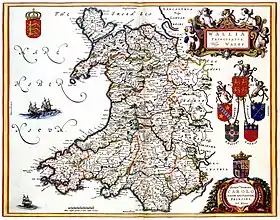Latin versions of "King of Wales" (Welsh: Brenin Cymru) were titles used on a handful of occasions in the Middle Ages. They were very seldom claimed or applied by contemporaries, because Wales, much like Ireland, usually had neither the political unity nor the sovereignty of other contemporary European kingdoms such as England and Scotland. While many early rulers of areas within Wales used the title of "King", they were not, and did not claim to be, rulers of all Wales.
Geoffrey of Monmouth's History of the Kings of Britain achieved wide circulation from 1136. It has little historical value, but it popularised a list of legendary kings of Britain that remains influential.[1] Therefore, the people associated with Monmouth's work are largely seen as fictitious, despite being a clear list from before AD, the work assembled was inconsistent as the chronology of his work is impossible to determine a correct timeline.[2]
Gruffydd ap Llywelyn
.svg.png.webp)
The modern territory of Wales was briefly united under the rule of Gruffydd (or Gruffudd) ap Llywelyn from 1055 to 1063. His 8-year tenure gave Wales a unity, Gruffudd made territorial gains eastwards from the traditional boundaries of Wales by making an alliance with the Kingdom of Mercia, more so than any other Welsh leader in the 11th century. Brut y Tywysogion quoted him as being "the head and shield of the Britons".[3][4] John of Worcester referred to him as Rex Walensium, King of the Welsh.[3] There is no evidence that Gruffydd ap Llywelyn himself ever claimed the title of King of Wales, or that it was recognized by other states.
Some modern authors have applied the title of King of Wales to Gruffydd ap Llywelyn. "In 1055 he conquered Deheubarth as well, thus becoming in effect King of Wales".[5] John Davies states that Gruffydd was "the only Welsh king ever to rule over the entire territory of Wales... Thus, from about 1057 until his death in 1063, the whole of Wales recognised the kingship of... Gruffudd ap Llywelyn".[3]
After his betrayal and death at the hands of his own men, Wales again became disunited, and was reunited only by the Conquest of Wales by Edward I.[6]
Use by regional rulers
The title King of Wales was later used by at least one other Welsh ruler, Owain Gwynedd (c. 1100–1170). His direct rule was, however, limited to Gwynedd. In his first two letters to Louis VII of France, Owain described himself as "king of Wales" and "king of the Welsh".[7] Nevertheless, his last letter to Louis used the title Prince; Owain was also the first Welsh ruler to claim the title of Prince of Wales.[8]
After the death of Owain Gwynedd in 1170, Rhys ap Gruffydd (c. 1132–1197), was called "Head of all Wales" by the Brut y Tywysogion on his death in 1197. His direct rule was limited to Deheubarth.
Prince of Wales
Since the death of Owain Glyndŵr in 1415, the title of Prince of Wales has only been held by non-native heirs to the English (and later British) monarchy.[4]
| History of Wales |
|---|
 |
|
|
See also
References
- ↑ Tatlock, J. S. P. (1950). The Legendary History of Britain: Geoffrey of Monmouth's Historia Regum Britanniae and its early vernacular versions. Berkeley: University of California Press.
- ↑ Bartrum, Peter (1993). A Welsh Classical Dictionary: People in History and Legend Up to about A.D. 1000. National Library of Wales. p. 2-3. ISBN 0907158730.
- 1 2 3 K. L. Maund (1991). Ireland, Wales, and England in the Eleventh Century. Boydell & Brewer Ltd. pp. 64–67. ISBN 978-0-85115-533-3.
- 1 2 Turvey, Roger (2010). Twenty-One Welsh Princes. Conwy: Gwasg Carreg Gwalch. pp. 11, 30–31. ISBN 9781845272692.
- ↑ Fletcher, Richard (1989). Who's who in Roman Britain and Anglo-Saxon England. Shepheard-Walwyn. p. 245. ISBN 0-85683-089-5.
- ↑ Davies, John (1993). A History of Wales. London: Penguin. p. 100. ISBN 0-14-014581-8.
- ↑ Carpenter, David (2004). The struggle for mastery. Penguin. ISBN 9780140148244.
- ↑ Huw, Pryce (1998). "Owain Gwynedd And Louis VII: The Franco-Welsh Diplomacy of the First Prince of Wales". Welsh History Review. 19 (1): 1–28.